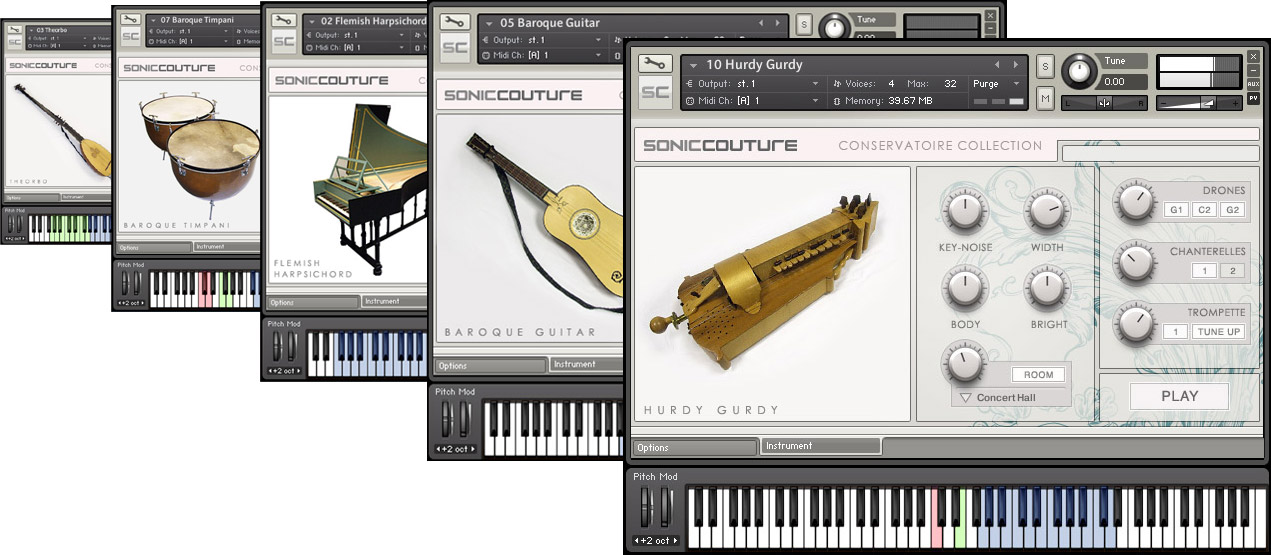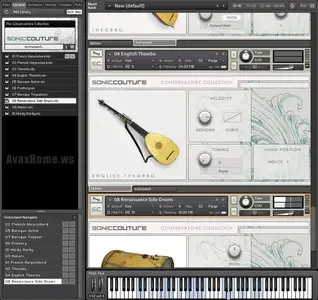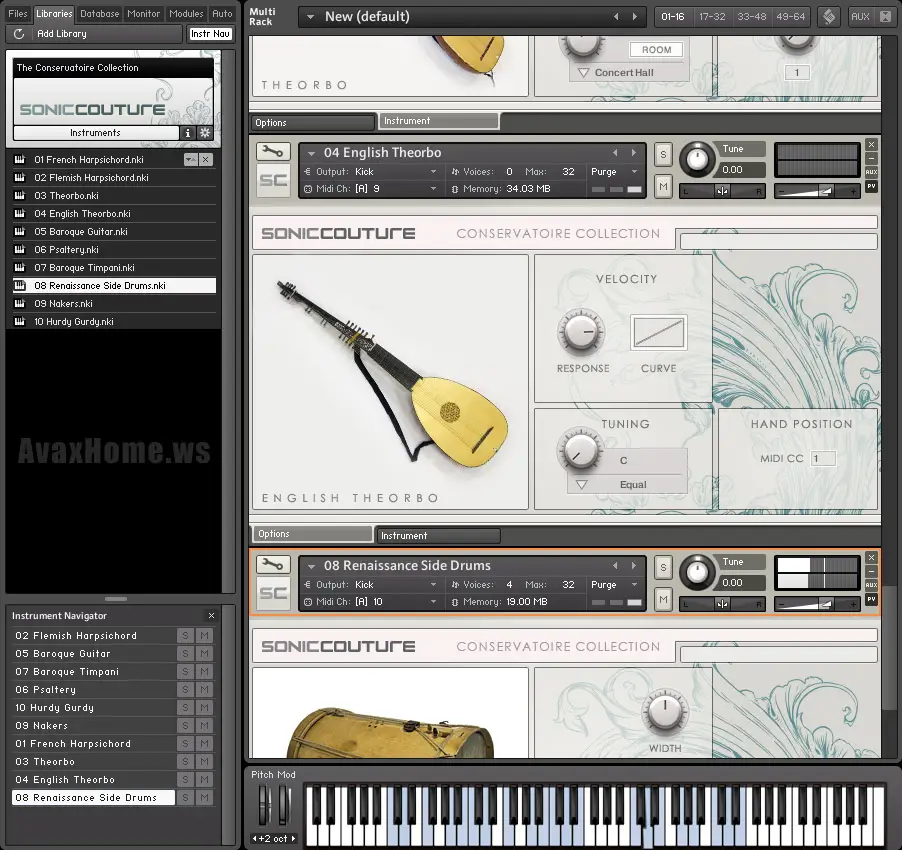SonicCouture The Conservatoire Collection COMPLETE KONTAKT | 8.76 Gb
Explore the soundworlds of the masters. The instruments of the great composers are museum pieces now; hundreds of years old and not in playable condition. But in recent times period instrument specialists have begun recreating our musical past in the form of reproduction instruments. By sourcing authentic materials and using traditional techniques from the 16th, 17th and 18th centuries, incredibly accurate copies of the finest historical instruments can be produced. These beautiful new instruments bring the soundscape of our musical past to life, showing us how incredibly diverse our modern instruments' predecessors were. We are now able to enter into our musical heritage more faithfully, and the new palette of sounds available offers fresh inspiration for composers today.
01. French Harpsichord
This instrument is a copy of a harpsichord originally made by Paul Taskin in 1762 and later enlarged by Jean Goermanns in 1780.The original instrument is one of the most copied 18th century harpsichords, Michael Johnson's copy is highly regarded as a faithful reproduction.
- Full tuning control with user selectable scales
- Two switchable 8' string sets, with damping
- Key-off samples with level control
- Round robin samples for natural response
02. Flemish Harpsichord
A Michael Johnson copy of a harpsichord made by Johannes Ruckers, made in 1637. The copy used for the sample library was made in 2000 by Michael Johnson. Generally speaking, 17th century harpsichords are smaller, and, significantly, shorter than those of the 18th century.
- Full tuning control with user selectable scales
- 2 x 8' with damping and 4' string sets
- Key-off samples with level control
- Round robin samples for natural response
03. Theorbo
A single-strung, 14 course instrument made by Martin Haycock in 2005, after various seventeenth century Italian originals. This late Renaissance invention was the ultimate accompanying instrument of the time - by adding an extension to the neck, thick strings giving low notes were placed alongside the conventional lute meaning a player could play a bass- line and give the rhythm.
- Fret Hand postion control: gives you control over where on the fretboard the note will be played
- Full tuning control with user selectable scales
- Seperate release control for the frets and diapazon
04. English Theorbo
Although there are no surviving original instruments, there are several descriptions, illustrations and paintings of English theorbos dating from the mid- 17th C. This instrument was made by Klaus Jacobson in 2005. The English theorbo has much in common with the small 12-course lute, from which it developed, but it takes elements of the larger, Italian theorbo, such as the deep body.
- Fret Hand postion control: gives you control over where on the fretboard the note will be played
- Full tuning control with user selectable scales
- Seperate release control for the frets and diapazon
05. Baroque Guitar
A French style, five- course instrument: a copy of various seventeenth century originals, made by Martin Haycock. The stringing of the instrument is unusual: the five courses correspond with the top strings of modern guitars, but they are double-strung apart from the top E. During the early 17th C, the guitar was primarily used as an accompanying instrument, playing for dances or accompanying singers.
- Fret Hand postion control: gives you control over where on the fretboard the note will be played
- Full tuning control with user selectable scales
- Convolution Room processor
06. Psaltery
The Psaltery is one of the oldest of all musical instruments, mentioned in the Bible and in numerous ancient Greek texts. A Psaltery is a diatonic instrument, used to play chords or melodies. It is played by plucking the strings with quills, one in each hand. As the notes are not stopped by the player, the long decay time give this instrument an ethereal quality.
- Full tuning control with user selectable scales
- Round robin layers for natural response
07. Baroque Timpani
The successor to the nakers - primarily an outdoor instrument - was the timpani. Used at first for ceremonial occasions with trumpets, by the 18th century the timpani found a new home in the orchestra. The drums are smaller compared to their modern counterparts, they use calf-skin drum heads, and are tuned to different notes without the aid of pedals.
- 3 Articulations : Hit, Roll and Trill
- Selectable leather and wooden beaters
- Round robin layers for natural response
08. Renaissance Side-drum
This is a medium large drum with a long shell and skins at either end held in place by wooden rings. The skins can be tightened and on the lower skin there is a snare mechanism made from two gut strings.
- Stick, trill and roll articulations
- Round robin layers for natural response
09. Nakers
A naker is a small drum, of Arabic origin, with a metal or wood dome-shaped body and animal skin drum head. Played in pairs, nakers made their way to Europe at the time of the Crusades in the thirteenth century. The instruments sampled were copies of the pair in the Montagu collection.
- Left and right hand mapping
- Round robin layers for natural response
10. Hurdy Gurdy
This instrument is a copy of a sixteenth century original in the Gemeentemuseum, The Hague, and is typical of those of the late Renaissance. A typical hurdy gurdy of the mid-Renaissance era featured three drones strings (made of gut), two melody strings and a further higher drone string used for rhythm, known as the trompette. This features a buzzing bridge (chien - literally "dog") which creates a harsh sound when the player increases pressure on the wheel. Traditionally, the player would play turn the wheel to the tempo of the music, using his wrist to effect a rhythm whilst turning the wheel. The last two strings (chanterelle(s)), are the melody strings. The nature of the hurdy gurdy is one of an all-in-one melody, harmony and rhythm instrument. Even without the player consciously playing rhythmically, and playing without the melody strings chanterelles or the buzzing trompette drone, there is a natural rhythmic fluctuations with each cycle of the wheel.
- 3 Drone strings : G1, C2, G2 layout,
- 2 Chanterelle stringstuned in unison at G3.
- Trompette string : a higher Cor "Tuned Up" to D.
- 'Buzz key' for rhythmic playing
- Key noise control
Kontakt 4.2.3 or higher required
SoCrCnsr.part01.rar BF6528D5
SoCrCnsr.part02.rar 9D13F284
SoCrCnsr.part03.rar F18EA68C
SoCrCnsr.part04.rar 460DA1AB
SoCrCnsr.part05.rar 8DDBFD1B
SoCrCnsr.part06.rar 7555546F
SoCrCnsr.part07.rar F5E984D3
SoCrCnsr.part08.rar 13E2FE2A
SoCrCnsr.part09.rar 2D9B2C99
SoCrCnsr.part10.rar 31DD75B7
SoCrCnsr.part11.rar A7077D7B
SoCrCnsr.part12.rar DA88D093
SoCrCnsr.part13.rar 4587A458
SoCrCnsr.part14.rar AE347FEB
SoCrCnsr.part15.rar FB120E00
SoCrCnsr.part16.rar 68D0CBBD
SoCrCnsr.part17.rar 444BC4D1
SoCrCnsr.part18.rar 4500C662
SoCrCnsr.part02.rar 9D13F284
SoCrCnsr.part03.rar F18EA68C
SoCrCnsr.part04.rar 460DA1AB
SoCrCnsr.part05.rar 8DDBFD1B
SoCrCnsr.part06.rar 7555546F
SoCrCnsr.part07.rar F5E984D3
SoCrCnsr.part08.rar 13E2FE2A
SoCrCnsr.part09.rar 2D9B2C99
SoCrCnsr.part10.rar 31DD75B7
SoCrCnsr.part11.rar A7077D7B
SoCrCnsr.part12.rar DA88D093
SoCrCnsr.part13.rar 4587A458
SoCrCnsr.part14.rar AE347FEB
SoCrCnsr.part15.rar FB120E00
SoCrCnsr.part16.rar 68D0CBBD
SoCrCnsr.part17.rar 444BC4D1
SoCrCnsr.part18.rar 4500C662





